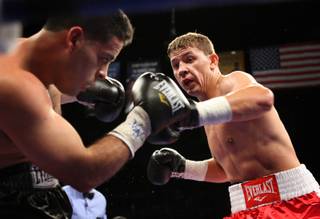
Julio Cesar Chavez Jr. of Mexico, pictured training in October, is scheduled to battle Luciano Cuello of Argentina in a meeting of undefeated junior middleweights March 28 in Tijuana, Mexico. Because of drug-related crime in Mexican border cities, tens of thousands of Marines stationed in Southern California are forbidden from attending.
Saturday, March 14, 2009 | 2 a.m.
Sun Blogs
Sun Archives
The image of Las Vegas as a tourist destination has taken a hit of late, with corporate executives wondering whether the city has become too frivolous for their business getaways given the dismal economy.
Any criticism leveled against Las Vegas, however, has been benign compared with the jabs aimed at Tijuana, the Mexican border city that hosts a Top Rank boxing card March 28 headlined by Julio Cesar Chavez Jr.
During the Christmas holiday, the commanding officer of the 1st Marine Expeditionary Force at Camp Pendleton ruled Tijuana off-limits for tens of thousands of Marines based in Southern California.
The order, prompted by concerns about deadly drug-related violence throughout Mexico, has been extended indefinitely. Violators of the ban could face a court-martial.
Then, in February, the State Department issued a travel alert advising Americans of the risks of traveling in Mexico. The alert emphasized an increase in violence in Mexican border cities.
“Some recent Mexican army and police confrontations with drug cartels have resembled small-unit combat, with cartels employing automatic weapons and grenades,” the State Department alert read in part. “Large firefights have taken place in many towns and cities across Mexico but most recently in northern Mexico, including Tijuana, Chihuahua City and Ciudad Juarez. During some of these incidents, U.S. citizens have been trapped and temporarily prevented from leaving the area ...
“Robberies, homicides, petty thefts, and carjackings have all increased over the last year across Mexico generally, with notable spikes in Tijuana and northern Baja California. Ciudad Juarez, Tijuana and Nogales are among the cities which have recently experienced public shootouts during daylight hours in shopping centers and other public venues.”
The reports of violence led Top Rank Chairman Bob Arum to take the unusual step of addressing members of the boxing media in an effort to ease concerns about the safety of visitors to Tijuana.
Arum, joined by Mexican government officials on a conference call, insisted that boxing fans from either side of the border would have a safe and pleasant experience on fight night at the Plaza de Toros Monumental. The 22,000-seat bullring sits by the beach 98 feet from the U.S. border, though it’s a 15-minute drive from the border crossing.
“There has been an extraordinary amount of violence in Juarez, we know that,” Arum said. “I wouldn’t look to go to Juarez. But in Tijuana there has been an absence of violence, and it’s wrong for the State Department to paint all of Mexico with a broad brush.”
Arum has vacationed in Cabo San Lucas, on the other end of Baja California peninsula, for the past eight years, though he was also bullish on the restaurants of Tijuana: “I can tell you from firsthand experience, the best food in the world.”
“We have information from the authorities that Tijuana is a very safe place,” Arum said. “I know there have been some problems in Tijuana with the drug trafficking, but I think that a lot of it is under control. Any tourist coming to the fight is not going to have any problems. It’s a safe, vibrant city.”
Oscar Escobedo, the secretary of tourism for Baja California, cited the safety measures that would be taken on fight night. They include a secured route from the border crossing to the bullring, 24-hour emergency phone lines, including cell-phone access to 911, and more than 200 volunteers on hand to assist visitors.
Even though a nephew of his lost his life in the border violence, Escobedo insisted Tijuana, a city of 2 million, remains a safe destination — probably more so than New Orleans or Washington, D.C., he said.
He cited a recent article in the San Diego Union-Tribune that included a statement from the FBI that Tijuana is safer now than it was in 2006 or 2007. As in any big city, using common sense goes a long way in protecting yourself, he said.
“It’s just a specific group of people who are in an illegal business” and responsible for the drug-related violence, Escobedo said. “The rest of the city is a very nice and safe place. I live in Tijuana. My kids live in Tijuana.
“As far as tourism is concerned, Baja California, and Tijuana in particular, is a safe place. It’s a great place to visit and a great opportunity to come see the fights.”
The card, available on pay per view, does contain a solid lineup. Chavez Jr., a Mexican fan favorite, fights Luciano Cuello of Argentina in a clash of unbeaten junior middleweights.
Humberto Soto faces Antonio Davis in a WBC super featherweight title fight. Fernando Montiel meets Diego Silva in a bantamweight 12-rounder. Former world champ Jose Luis Castillo fights Antonio Diaz in a 10-round welterweight bout.
Despite the troubles his city has experienced, Jorge Ramos, the mayor of Tijuana, predicted a sellout at the bullring.



Join the Discussion:
Check this out for a full explanation of our conversion to the LiveFyre commenting system and instructions on how to sign up for an account.
Full comments policy